In many Kenyan homes and farms, water pumps are essential for ensuring steady supply from storage tanks, boreholes, or irrigation systems. But one of the most frequent challenges especially in compact urban setups or open compounds is excessive pump noise.
This guide outlines practical, locally suitable methods to reduce pump noise without affecting performance. From soundproof housing to vibration control, we show you how to create a quieter, more comfortable water system.
1. Why Is Your Pump Noisy?
Common sources of noise in water pumps include:
- Vibrations from loose mounting or unstable floors
- Pump cavitation caused by trapped air
- Worn-out bearings or misaligned shafts
- Rigid pipe connections that transfer noise
- Placement near hard surfaces or echo chambers
Before making adjustments, always ensure your pump is in good working condition. Learn routine maintenance tips in How to Clean and Maintain Household Tanks, which covers basic servicing practices.
2. Improve Pump Placement
One of the easiest ways to reduce noise is by relocating or repositioning the pump:
- Install pumps away from bedrooms or living areas
- Use solid, vibration-dampened concrete slabs as the base
- Avoid placing pumps directly on metal sheets or hollow blocks
- Keep pumps away from corners or enclosed spaces that echo
Combining your pump with a sheltered utility area can also help. See examples in Tank Shelters and Lockable Enclosures.
3. Build a Noise-Reducing Enclosure
You can build a small insulated shelter or cabinet to contain pump noise. Use:
- Concrete blocks or treated timber for walls
- Foam lining or discarded carpets for sound insulation
- Sound-baffled air vents to allow airflow
- Rubber grommets where pipes exit the enclosure
For outdoor and farm setups, consider mobile or elevated housing. See Pump Protection Shelters in Kenya for shelter design suited to Kenyan conditions.
4. Use Sound-Absorbing and Vibration-Dampening Materials
Noise reduction doesn’t always require full enclosure. Try:
- Placing rubber or foam mats under the pump
- Using flexible pipe connectors to absorb vibration
- Wrapping exposed pipework with pipe insulation foam
- Mounting booster pumps on anti-vibration brackets
If your setup uses gravity-fed systems, noise may also come from tank overflow or refill lines. Learn how to quieten these in Gravity-Fed Tank Setups.
5. Switch to Quieter Pump Types
If noise is persistent despite modifications, upgrading to a different pump type can help:
- Submersible pumps operate underwater and are significantly quieter
- DC solar pumps run at low voltage and are designed for minimal noise
- Variable-speed pressure pumps adjust flow based on demand, reducing harsh starts
Explore pump choices tailored for low-noise performance in Solar-Powered Water Pumps for Rural Tanks.
6. Maintain and Service Regularly
Many noise issues stem from poor maintenance. To keep your pump running quietly:
- Lubricate motor and shaft bearings
- Check for loose nuts, bolts, or misaligned parts
- Replace worn-out washers or gaskets
- Flush out airlocks that cause cavitation
If your pump is part of a larger off-grid system, regular maintenance is key. Learn how to keep your system reliable in Off-Grid Water Planning for Farms.
Water pump noise can disrupt home comfort or cause unnecessary stress in shared compounds. Fortunately, with proper planning, strategic placement, and a few insulation upgrades, you can run your water system with far less disturbance.
Whether you use a solar-powered booster, a petrol irrigation pump, or a domestic pressure unit, investing in noise reduction improves both comfort and system longevity.


